NASA set to crash DART probe into asteroid as test for future collisions
The space agency will attempt to knock Domorphos off its orbit using a technique that could hopefully one day save the Earth from potentially life-destroying impacts

Didymos
DART
spacecraft
LICIACube
mini-satellite
Dimorphos
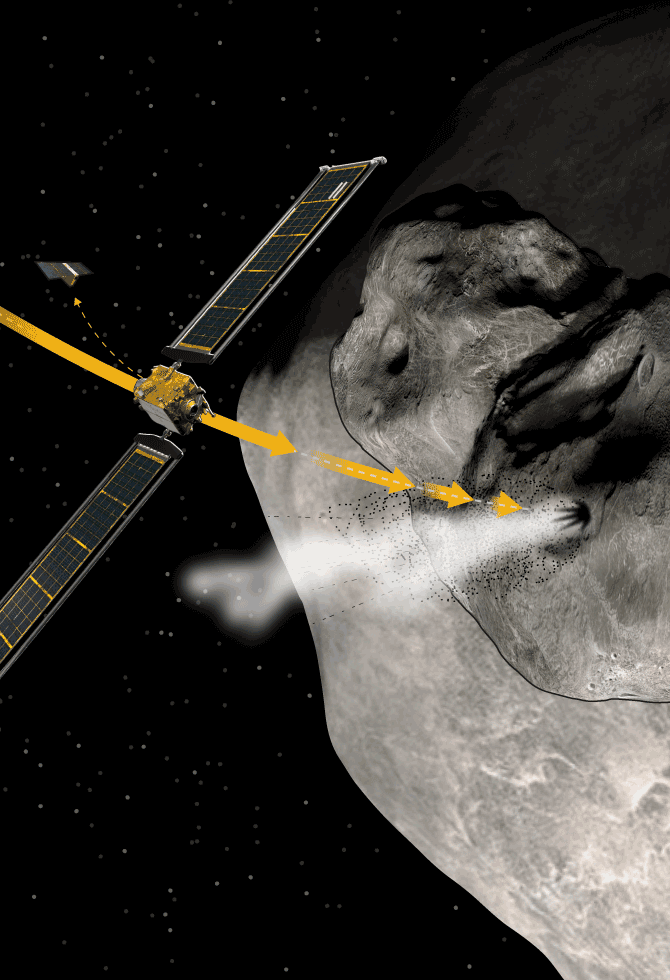
Didymos
DART
spacecraft
LICIACube
mini-satellite
Dimorphos
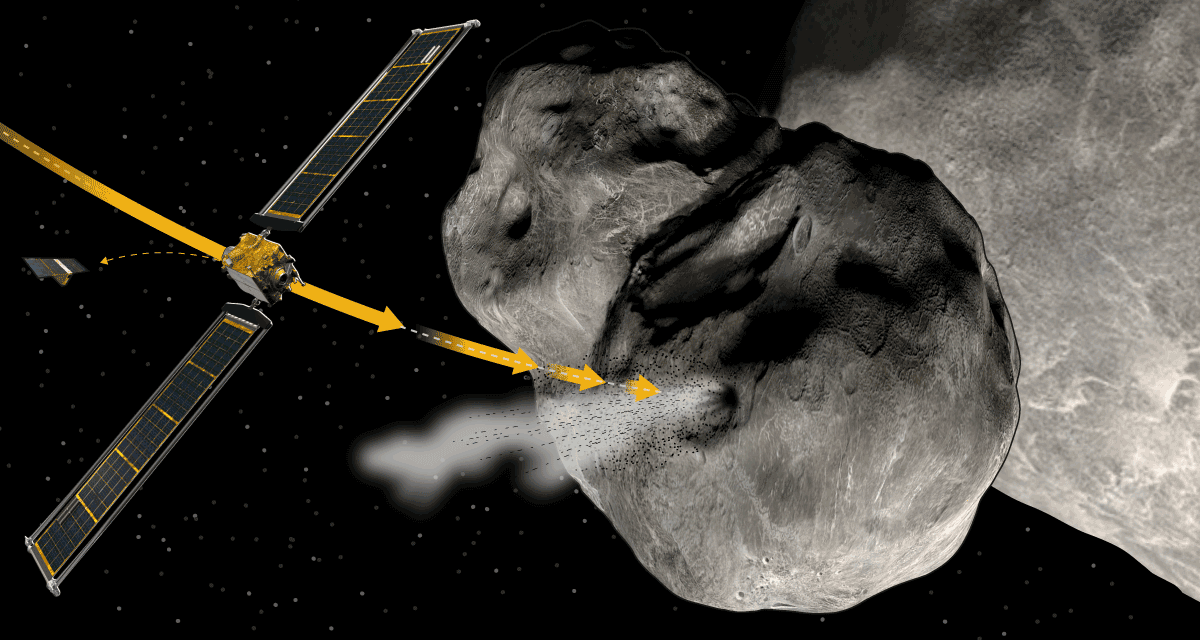
Didymos
DART
spacecraft
LICIACube
mini-satellite
Dimorphos
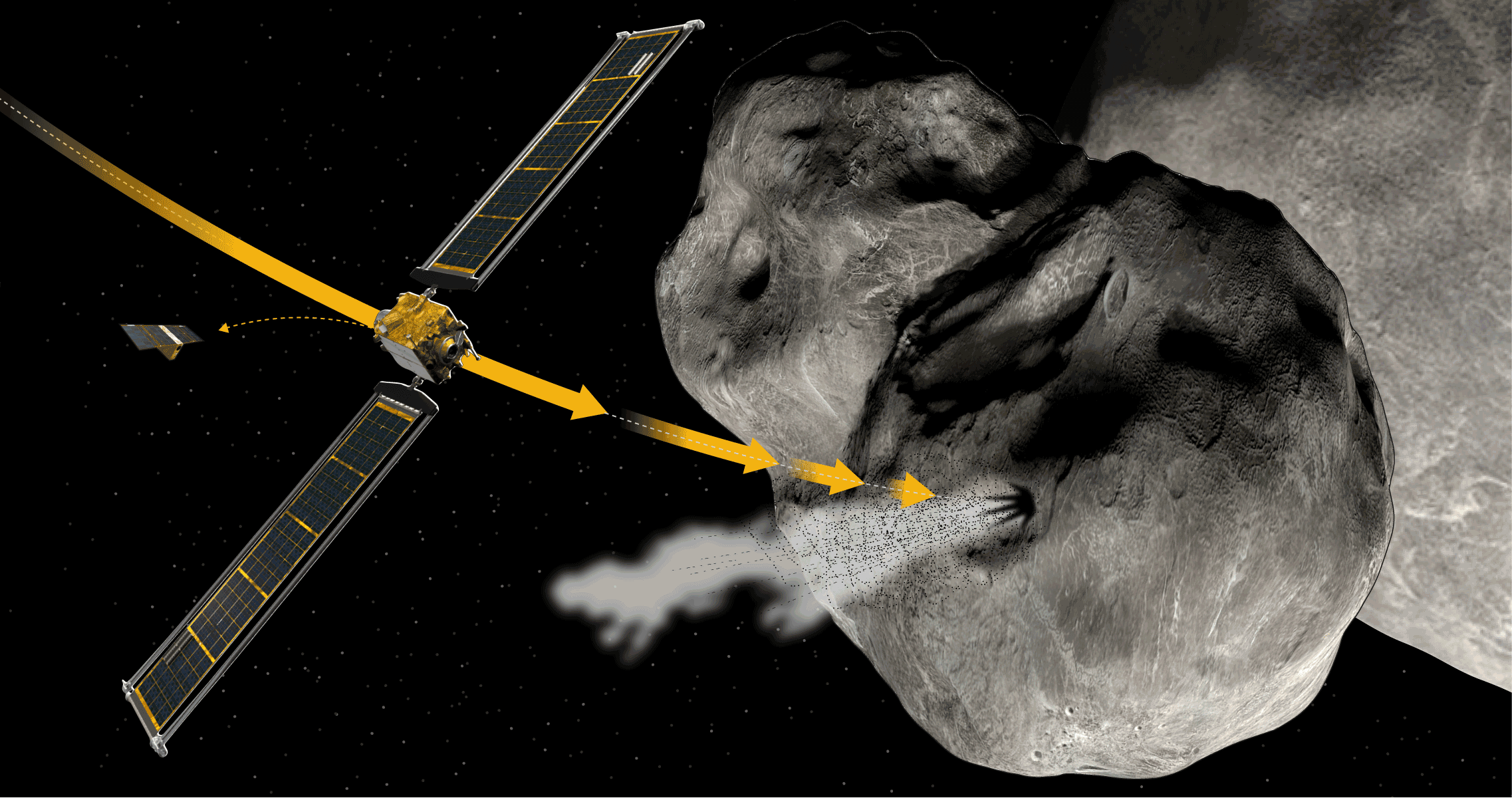
Didymos
DART
spacecraft
LICIACube
mini-satellite
Dimorphos
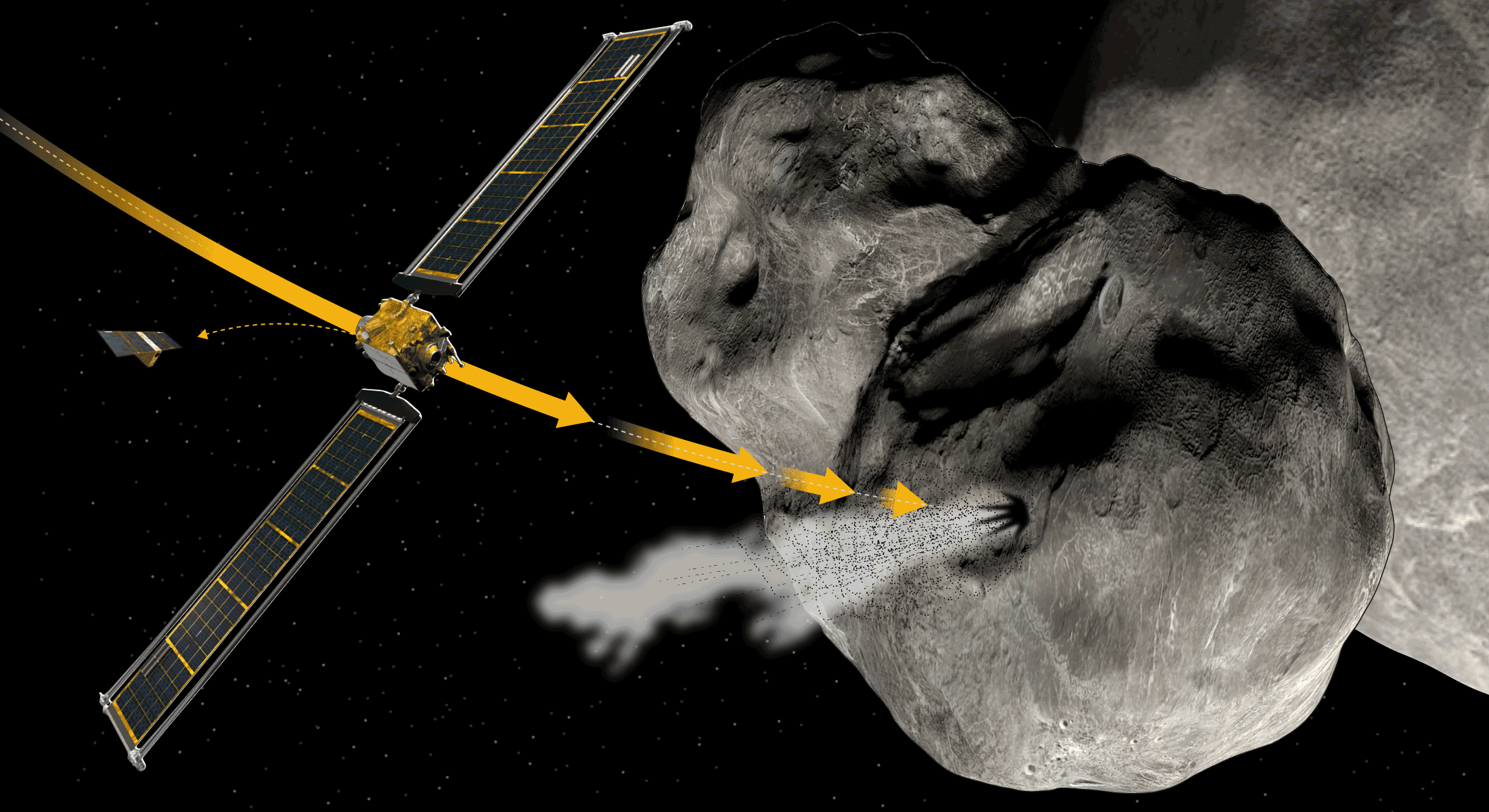
Didymos
DART
spacecraft
LICIACube
mini-satellite
Dimorphos
A space probe the size of a refrigerator will collide head-on and at full speed with an asteroid 11 million kilometers from Earth. The impact is timed for 23.14 UTC on Monday. It marks the first time that humankind has tried to change the trajectory of a celestial body, a mission intended to help avert an asteroid collision in the future.
“We’re trying to make sure that a rock from space doesn’t send us back to the Stone Age,” said Thomas Statler, from NASA’s Planetary Defense Coordination Office, when the mission launched in 2021.
So far, researchers have identified more than 95% of all asteroids that are larger than one kilometer in diameter. These asteroids are capable of causing a planetary disaster similar to the extinction of the dinosaurs 66 million years ago. Of greater concern are asteroids measuring 140 meters (460 feet) or more, of which only 40% have been identified. These have the same destructive power of a nuclear bomb, and could open a two-kilometer wide crater in the Earth. But given the so few have been recorded, there could be thousands of asteroids of this size on a collision course with Earth.
“The probability of an asteroid hitting in your lifetime is about the same as your house burning down,” Statler told EL PAÍS by phone. “If we have home insurance to ensure we don’t end up on the street, why not be better prepared in case of an asteroid?”
The threat is so significant that in 2017 NASA approved $324 million in spending to make the DART mission a reality. DART is an acronym for Double Asteroid Redirection Test. The spacecraft was launched in November 2021 and is currently heading towards a pair of asteroids: Didymos, measuring 780 meters in diameter, and its moonlet, Dimorphos, which orbits Didymos every 11.9 hours.

Impact
The mission will test the effectiveness of modifying the speed and trajectory of an asteroid with a deep space collision.
The DART spacecraft is small and light.
2.6 m
570 kg
1.8 m
The spacecraft is tiny compared to the asteroid.
Dimorphos
DART
spacecraft
570 kg
5,000,000,000 kg
(estimate)
But its great speed means that some of the energy from the collision should alter Dimorphos’ orbit around Didymos
Original orbit
New orbit
1.2 km
Didymos
Dimorphos
The spacecraft will hit at 21,960 km/h. If it were a commercial plane, at this speed, it would cross the North Atlantic at its widest point in less than 19 minutes.
18m 35s
The mission is an exercise in marksmanship: the DART spacecraft is a 160-meter-wide, moving target that is seven million miles from Earth
LICIACube
mini-satellite
Tamaño
comparado
DART spacecraft
17 m
Dimorphos
160 m
A-380
79.8 m
A-320
34.1 m
Didymos
780 m
The trip to Dimorphos has taken 306 days. During this time, the spacecraft has been surveying the sky. About four hours before impact, the spacecraft will be on autonomous targeting using its smart navigation system.

Impact
The mission will test the effectiveness of modifying the speed and trajectory of an asteroid with a deep space collision.
The DART spacecraft is small and light.
2.6 m
570 kg
1.8 m
The spacecraft is tiny compared to the asteroid.
Dimorphos
DART
spacecraft
570 kg
5,000,000,000 kg
(estimate)
But its great speed means that some of the energy from the collision should alter Dimorphos’ orbit around Didymos
Original orbit
New orbit
1.2 km
Didymos
Dimorphos
The spacecraft will hit at 21,960 km/h. If it were a commercial plane, at this speed, it would cross the North Atlantic at its widest point in less than 19 minutes.
18m 35s
The mission is an exercise in marksmanship: the DART spacecraft is a 160-meter-wide, moving target that is seven million miles from Earth
LICIACube
mini-satellite
DART
spacecraft
Tamaño
comparado
17 m
Dimorphos
160 m
A-380
79.8 m
A-320
34.1 m
Didymos
780 m
The trip to Dimorphos has taken 306 days. During this time, the spacecraft has been surveying the sky. About four hours before impact, the spacecraft will be on autonomous targeting using its smart navigation system.
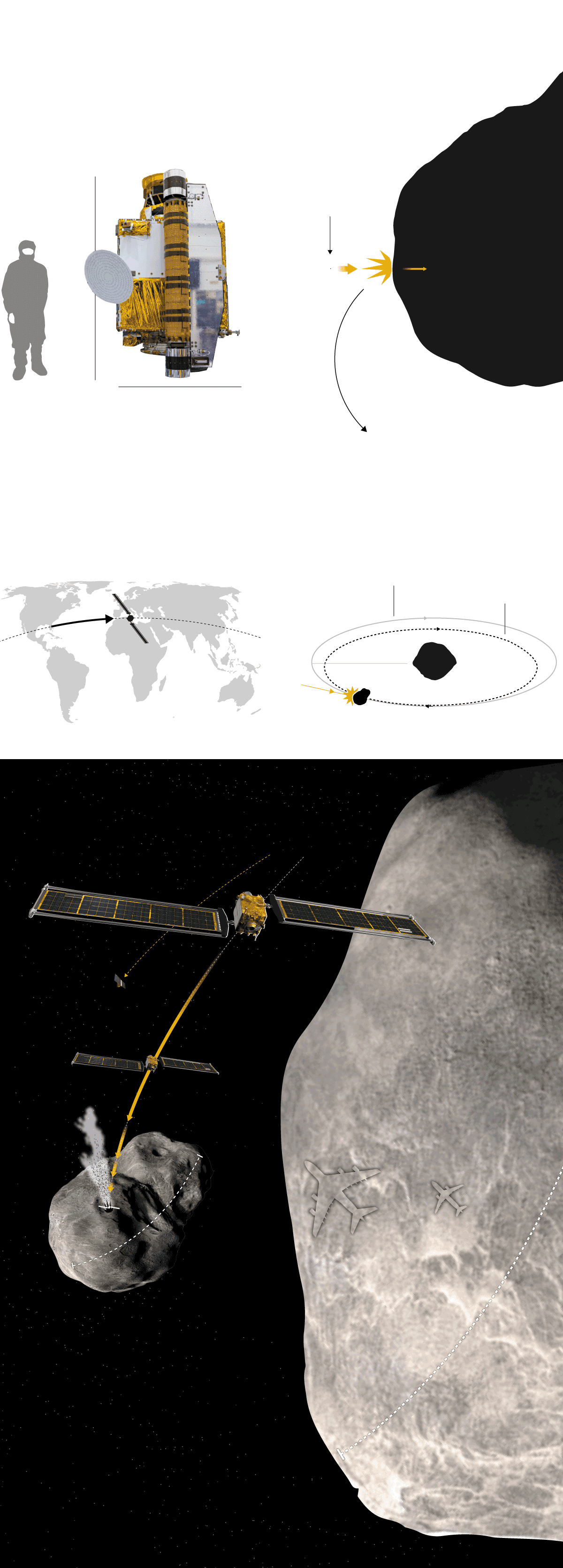
Impact
The mission will test the effectiveness of modifying the speed and trajectory of an asteroid with a deep space collision.
The spacecraft is tiny compared to the asteroid.
The DART spacecraft is small and light.
DART
spacecraft
Dimorphos
2.6 m
570 kg
5,000,000,000 kg
(estimate)
570 kg
1.8 m
But its great speed means that some of the energy from the collision should alter Dimorphos’ orbit around Didymos
The spacecraft will hit at 21,960 km/h. If it were a commercial plane, at this speed, it would cross the North Atlantic at its widest point in less than 19 minutes.
Original orbit
New orbit
18m 35s
1.2 km
Didymos
Dimorphos
The mission is an exercise in marksmanship: the DART spacecraft is a 160-meter-wide, moving target that is seven million miles from Earth
LICIACube
mini-satellite
DART
spacecraft
17 m
Dimorphos
A-380
A-320
160 m
79.8 m
34.1 m
Comparative size
The trip to Dimorphos has taken 306 days. During this time, the spacecraft has been surveying the sky. About four hours before impact, the spacecraft will be on autonomous targeting using its smart navigation system.
Didymos
780 m
The spacecraft is equipped with an autonomous navigation system that will guide the probe to hit the center of Dimorphos at around 22 km (14 miles) per hour. DART weighs just 570 kilos, making it around 10 million times lighter than Dimorphos. But if all goes well, the impact will slow down the asteroid and nudge it towards Didymos, shortening its orbit by a few minutes. In other words, its orbit will be narrower by 15 meters, says Statler. It may not sound like much, but it’s quite an achievement considering that no one on the mission knows what the asteroid looks like or what it’s made of or how hard it is due to its distance. To ground-based telescopes, the asteroids are just a tiny point of indecipherable light.
The camera on board DART is expected to capture Dimorphos three-quarters of an hour before impact. At first, it will appear as a mere pixel of light. But in the 30 minutes before impact, this light will grow larger and larger with every second, the rate at which the spacecraft will take the images and send them back to Earth. In its last moments of life, the spacecraft will capture Dimorphos’ surface in enough detail that it will be able to distinguish stones the size of oranges. And then nothing. The first proof that DART has hit its target will be signal loss. The silence will be captured by the control center, located at the Johns Hopkins University Applied Physics Laboratory in the United States, and confirmed by NASA’s deep space antenna array.
Three minutes behind DART – about a thousand kilometers (632 miles) – is LICIACube, a small satellite developed by the Italian Space Agency. This toaster-sized device disengaged from the DART spacecraft a few days ago. After DART smashes into the asteroid, it will perform a fast fly-by at a minimum distance of about 55 km (34 miles) from Dimorphos’ surface, taking photos of the crater and the cloud kicked up by the collision. “We hope to have [the images] one or two days later at most,” says Stavro Ivanovski, an astrophysicist on the mission.
The trail of dust and dirt kicked up by DART will act as a booster rocket to help slow down the asteroid. The James Webb Space Telescope, Hubble Space Telescope and many ground-based observatories will point their lenses at the pair of asteroids to try to capture debris from the impact. The two asteroids work like a high-precision clock. When Dimorphos passes in front of Didymos, it produces a small eclipse that happens with perfect cadence. In the hours, days, or at most weeks after the collision, the telescopes will be able to confirm whether DART has succeeded in its second goal: changing the asteroid’s orbit.
Current models suggest that the most feasible way to avoid an impact from a medium-sized asteroid is to knock it off course with a spacecraft. The size of the spacecraft would depend on the time before collision and the type of asteroid in question. All possible parameters have been modeled with computers. The data from the DART mission “will help to show whether these models are correct, so that we can adapt them if an asteroid really threatens the Earth in the future,” said Isabel Herreros, a researcher from the Center of Astrobiology (CAB) near Madrid in Spain.
Even if the mission is a success, it will take years or decades of technological development to be able to manage this kind of threat. In 2024, the European Space Agency will launch Hera, a €130 million space probe that will reach Didymos and what is left of Dimorphos in 2026 to perform a post-impact survey. It is the first spacecraft capable of accurately determining the mass, composition and internal structure of these two asteroids. It will also create a detailed three-dimensional reconstruction of the crater left by DART. “We need tons of data to validate this technique for deflecting asteroid collisions, and Hera will be the mission that allows us to develop this new technology,” explained Ian Carnelli, the head of the project.
This planetary defense system could be ready in about 30 years, according to Carnelli. If there were a threat, one or several spacecrafts could be designed in two years, “a very short time for the pace of the space industry,” he said. This technique would work for asteroids coming from the outer part of the Solar System, but if an asteroid were to come from the opposite side, in the direction of the Sun, researchers may not be able to detect it until it is too late. This happened in the winter of 2013, when an asteroid fell on Siberia in Russia, causing more than 1,000 injuries due to shattered windows. It was barely 17 meters in diameter.
Tu suscripción se está usando en otro dispositivo
¿Quieres añadir otro usuario a tu suscripción?
Si continúas leyendo en este dispositivo, no se podrá leer en el otro.
FlechaTu suscripción se está usando en otro dispositivo y solo puedes acceder a EL PAÍS desde un dispositivo a la vez.
Si quieres compartir tu cuenta, cambia tu suscripción a la modalidad Premium, así podrás añadir otro usuario. Cada uno accederá con su propia cuenta de email, lo que os permitirá personalizar vuestra experiencia en EL PAÍS.
¿Tienes una suscripción de empresa? Accede aquí para contratar más cuentas.
En el caso de no saber quién está usando tu cuenta, te recomendamos cambiar tu contraseña aquí.
Si decides continuar compartiendo tu cuenta, este mensaje se mostrará en tu dispositivo y en el de la otra persona que está usando tu cuenta de forma indefinida, afectando a tu experiencia de lectura. Puedes consultar aquí los términos y condiciones de la suscripción digital.
More information
Últimas noticias
Mustafa Suleyman: ‘Controlling AI is the challenge of our time’
Venezuela breaks energy agreements with Trinidad and Tobago due to alleged complicity with the US
The murder of Michele and Rob Reiner: A tale of horrific days in Hollywood
Trump orders a ‘complete blockade of sanctioned oil tankers’ going to and from Venezuela
Most viewed
- ‘El Limones’ and the growing union disguise of Mexican organized crime
- Christian Louboutin: ‘Young people don’t want to be like their parents. And if their parents wear sneakers, they’re going to look for something else’
- ‘We are dying’: Cuba sinks into a health crisis amid medicine shortages and misdiagnosis
- A mountaineer, accused of manslaughter for the death of his partner during a climb: He silenced his phone and refused a helicopter rescue
- The low-cost creative revolution: How technology is making art accessible to everyone










































